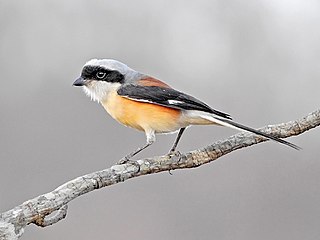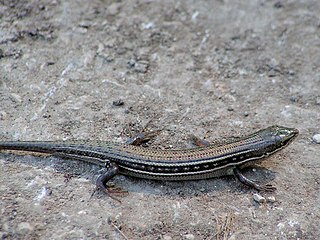
Basiliscus is a genus of large corytophanid lizards, commonly known as basilisks, which are endemic to southern Mexico, Central America, and northern South America. The genus contains four species, which are commonly known as the Jesus Christ lizard, or simply the Jesus lizard, due to their ability to run across water for significant distances before sinking due to the large surface area of their feet.

The bay-backed shrike is a member of the bird family Laniidae, the shrikes, resident in South Asia.

The brown basilisk, also commonly referred to as the striped basilisk or in some areas as the common basilisk, is a species of basilisk lizard in the family Corytophanidae. The species is native to Mexico, Central America and adjacent northwestern Colombia, and has been introduced into the U.S. state of Florida as an invasive species. The brown basilisk has large hind feet with narrow flaps of skin on the distal edge of each toe. The fact that it moves quickly across water gives it the appearance of "walking on water".

The greenstripe barb, silver barb or striped barb is a tropical freshwater and brackish fish belonging to the subfamily Cyprininae of the family Cyprinidae. It originates in inland waters in Asia, and is found in Pakistan, India, and Sri Lanka.

The striped bark scorpion is an extremely common scorpion found throughout the midsection of the United States and northern Mexico. It is perhaps the most frequently encountered scorpion in the U.S.

The striped keelback is a species of colubrid snake native to Indonesia. It has also been introduced to Singapore and Puerto Rico.

The bridled mabuya or bridled skink is a species of skink found in North Africa and Middle East. They grow up to 22 cm.

The southern banded newt is a species of salamander in the family Salamandridae found in Armenia, Iraq, Israel, Jordan, Lebanon, Syria, and Turkey. This species has two subspecies - O. v. vittatus and O. v. ciliensis.

The laced woodpecker is a species of bird in the family Picidae.

The greater broad-nosed bat is a species of bat in the family Phyllostomidae. It is found in Bolivia, Colombia, Costa Rica, Ecuador, Panama, Peru, and Venezuela.

The Indian Ocean oriental sweetlips, also known as the oriental sweetlips or oriental blubberlips, is a species of marine ray-finned fish, a sweetlips belonging to the subfamily Plectorhinchinae, one of two subfamilies in the family Haemulidae, the grunts. It is native to the Indian Ocean and the western Pacific Ocean.

Doxander vittatus, common name the vitate snail, is a species of medium-sized sea snail, a marine gastropod mollusk in the family Strombidae, the true snails.

Diplodactylus vittatus, commonly known as the eastern stone gecko, stone gecko, and wood gecko, is a species of diplodactylid lizards that occurs in forest, shrubland and arid regions across Australia. It is widespread across the states of Queensland, Victoria and New South Wales, commonly found in dry peripheral bushlands. This gecko can be kept as a pet or seen within zoo enclosures.

Donax vittatus, or the banded wedge shell, is a species of bivalve mollusc in the order Cardiida. It is found on beaches in northwest Europe buried in the sand on the lower shore.

Hydrocynus vittatus, the African tigerfish, tiervis or ngwesh is a predatory freshwater fish distributed throughout much of Africa. This fish is generally a piscivore but it has been observed leaping out of the water and catching barn swallows in flight.

The thinstripe hermit crab, Clibanarius vittatus, is a species of hermit crab in the family Diogenidae. It is found in the Caribbean Sea, the Gulf of Mexico and the western Atlantic Ocean.

Euryleptidae is a family of marine polyclad flatworms.

Mystus vittatus, the striped dwarf catfish, is a species of catfish of the family Bagridae. It is found in brackish water systems with marginal vegetation in lakes and swamps with a mud substrate of Asian countries Pakistan, India, Sri Lanka, Nepal, Bangladesh and probably Myanmar. Populations of Southeast Asian countries is in debate, due to close morphological similarities among Mystus species in that region.
Planipapillus vittatus is a species of velvet worm in the Peripatopsidae family. This species is oviparous, has 15 pairs of legs, and lives under dry logs. It is found in Victoria, Australia.
Vittatus is a genus of spiders in the family Linyphiidae. It was first described in 2014 by Zhao & Li.

















